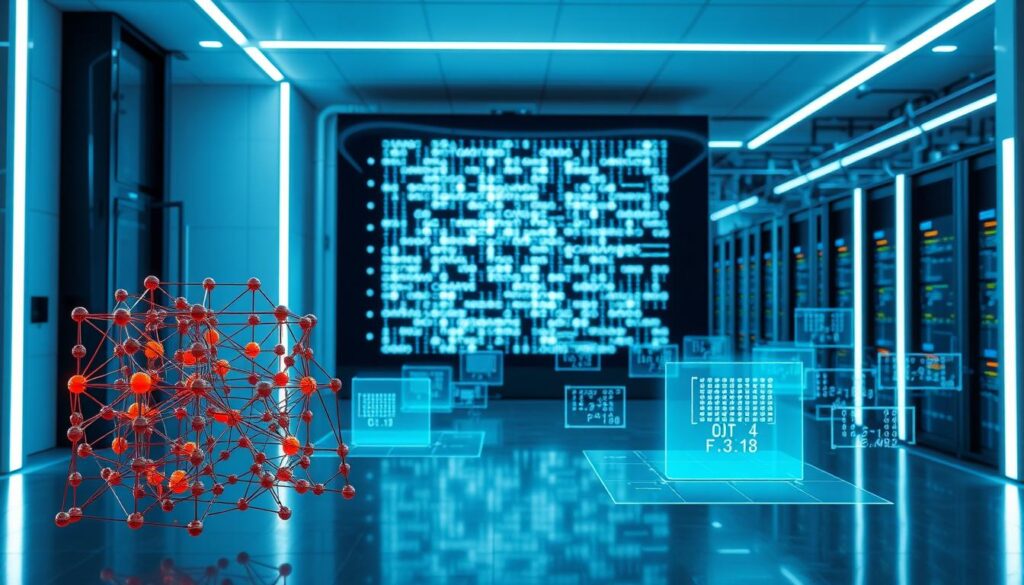Can a simple grid of numbers revolutionize the way we live and work? Matrices are more than just a mathematical concept; they are a powerful tool that has numerous practical applications in our daily lives.
From computer graphics to data analysis, matrices play a crucial role in shaping the modern world. They are used in various aspects of life, including image processing, cryptography, and even artificial intelligence
The significance of matrices extends beyond the realm of mathematics and computer science. They have become an essential tool in many industries, enabling professionals to make informed decisions and drive innovation.
Key Takeaways
- Matrices have numerous practical applications in daily life.
- They play a crucial role in computer graphics and data analysis.
- Matrices are used in image processing, cryptography, and artificial intelligence.
- They are an essential tool in many industries, driving innovation and informed decision-making.
- Understanding matrices can help individuals appreciate their significance in modern mathematics and AI.
Understanding Matrices: The Building Blocks of Modern Mathematics
Understanding matrices is key to grasping many modern mathematical and technological advancements. Matrices are powerful mathematical tools used to represent and manipulate data in various fields, from science and engineering to economics and computer graphics.
What Is a Matrix?
A matrix is a rectangular array of numbers, symbols, or expressions, arranged in rows and columns. It is a fundamental concept in linear algebra, used to solve systems of equations and perform linear transformations. Matrices are essential in representing complex data in a structured format, making them easier to analyze and manipulate.
Types of Matrices
There are several types of matrices, each with unique properties and applications. These include square matrices, where the number of rows equals the number of columns; diagonal matrices, with non-zero elements only on the diagonal; and identity matrices, which serve as the multiplicative identity in matrix multiplication. Understanding these types is crucial for applying matrices effectively in various contexts.
Basic Matrix Operations
Matrix operations are fundamental to applying matrices in real-world problems. These operations include:
Addition and Subtraction
Matrices can be added or subtracted element-wise, provided they have the same dimensions.
Multiplication
Matrix multiplication is a bit more complex, involving the dot product of rows and columns. It’s used extensively in linear transformations and data analysis.
Transposition
Transposing a matrix involves swapping its rows with columns, a useful operation in many mathematical and computational contexts.
| Operation | Description | Example Use |
|---|---|---|
| Addition | Element-wise addition | Combining data sets |
| Multiplication | Dot product of rows and columns | Linear transformations |
| Transposition | Swapping rows with columns | Data analysis and manipulation |
The Historical Evolution of Matrix Mathematics
Matrix mathematics, a cornerstone of modern computing and artificial intelligence, has a rich and varied history. The concept of matrices has evolved significantly over the centuries, from simple beginnings to the complex theories that underpin today’s technological advancements.
Ancient Roots of Matrix Calculations
The use of matrix-like structures dates back to ancient civilizations, where they were used for solving systems of linear equations. The ancient Chinese, for example, used a method similar to modern matrix operations in their mathematical texts.
Modern Development of Matrix Theory
The modern theory of matrices began to take shape in the 19th century with significant contributions from mathematicians such as Arthur Cayley and James Joseph Sylvester. They introduced concepts that are fundamental to the field today.
Contributions of Key Mathematicians
Mathematicians like Cayley and Sylvester laid the groundwork for modern matrix theory. Their work on matrix algebra and the introduction of terms like “matrix” have had a lasting impact.
Breakthrough Applications
The development of matrix theory has led to numerous breakthroughs in various fields, including physics, engineering, and computer science. Matrices are now crucial in applications ranging from computer graphics to data analysis.
Understanding the historical evolution of matrix mathematics provides insight into its current applications and future potential, particularly in areas like artificial intelligence and machine learning.
The Mathematical Power Behind Matrices
The mathematical power of matrices is evident in their ability to represent complex data and operations. Matrices are not just arrays of numbers; they are powerful tools that simplify intricate mathematical concepts, making them indispensable in various fields, including artificial intelligence and data analysis.
Linear Transformations
Linear transformations are a fundamental application of matrices. They enable the representation of complex operations, such as rotations and scaling, in a simplified form. This is crucial in computer graphics and machine learning, where matrices are used to manipulate images and data. Linear transformations facilitate the manipulation of multi-dimensional data, making matrices an essential component of modern computational methods.

Eigenvalues and Eigenvectors
Eigenvalues and eigenvectors are significant concepts in matrix mathematics. Eigenvalues represent the scalar by which a matrix stretches or shrinks its eigenvectors. These concepts are vital in understanding the stability and behavior of systems in physics and engineering. Eigenvectors help in identifying the directions in which a linear transformation acts, providing insights into the underlying structure of the data.
Determinants and Their Significance
Determinants are scalar values derived from matrices, providing information about the matrix’s properties, such as invertibility. They play a crucial role in solving systems of linear equations and understanding the geometric properties of transformations. Determinants are used to determine the solvability of equations and are a fundamental concept in linear algebra.
In conclusion, the mathematical concepts underlying matrices, such as linear transformations, eigenvalues, eigenvectors, and determinants, underscore their power and versatility. These concepts are pivotal in various practical uses of matrices, from matrix math in daily life to advanced matrix applications in AI.
How Are Matrices Used in Daily Life and Artificial Intelligence?
From smartphones to smart homes, matrices are the unsung heroes that make modern technology and artificial intelligence work seamlessly. Matrices play a vital role in various aspects of our daily lives, often behind the scenes.
The Omnipresence of Matrices in Everyday Technology
Matrices are integral to the functioning of many everyday technologies. They are used in:
Smartphones and Digital Devices
Matrix operations are crucial for image processing, signal processing, and graphics rendering in smartphones and other digital devices. For instance, camera applications use matrices to adjust image parameters like brightness and contrast.
Transportation Systems
In transportation, matrices help in optimizing traffic flow, route planning, and in the development of autonomous vehicles. They are used to process data from various sensors and cameras, enabling vehicles to make informed decisions.

Connecting Everyday Applications to AI Systems
The use of matrices in everyday technology is closely linked to advancements in artificial intelligence. AI systems rely heavily on matrix operations for various tasks:
From Search Engines to Voice Assistants
Search engines and voice assistants like Siri, Google Assistant, and Alexa use complex matrix algorithms to understand and process natural language, providing relevant search results and responses.
Smart Home Technology
In smart home systems, matrices are used to integrate and control various devices, enhancing home automation and security. They help in processing data from sensors and making decisions based on the data analyzed.
As matrices continue to play a crucial role in advancing AI and daily technology, their significance cannot be overstated. As Dr. Gilbert Strang, a renowned mathematician, once said, “Linear algebra, and matrices in particular, is the language of much of modern applied mathematics and science.”
“The beauty of mathematics is that it can be used to describe the world around us, and matrices are a fundamental part of that description.”
By understanding and leveraging matrices, we can continue to innovate and improve various aspects of our lives, from how we interact with technology to how AI systems are developed.
Matrices in Digital Imaging and Graphics
In the realm of digital imaging and graphics, matrices serve as a fundamental tool for image processing and computer graphics. Matrices enable the transformation and manipulation of images, facilitating a wide range of applications from simple image editing to complex 3D modeling.
Image Processing Fundamentals
Image processing relies heavily on matrix operations to perform tasks such as image filtering, resizing, and enhancement. For instance, applying a filter to an image involves convolving the image data with a kernel matrix, which modifies the pixel values to achieve the desired effect.

Computer Graphics and 3D Modeling
Computer graphics and 3D modeling utilize matrices to perform transformations such as rotation, scaling, and translation. These transformations are crucial for rendering 3D objects on a 2D screen, creating the illusion of depth and movement.
Video Game Development
In video game development, matrices are used to simulate realistic environments and character movements. By applying matrix transformations, game developers can create complex animations and interactions.
Animation and Special Effects
Matrices are also essential in the production of animation and special effects in movies. They enable the creation of realistic simulations, such as water, fire, and cloth dynamics, enhancing the visual experience.
Facial Recognition Systems
Facial recognition systems rely on matrix-based algorithms to analyze and compare facial features. By representing facial data as matrices, these systems can efficiently identify and verify individuals.
| Application | Matrix Operation | Outcome |
|---|---|---|
| Image Filtering | Convolution with kernel matrix | Enhanced or modified image |
| 3D Modeling | Rotation, scaling, translation matrices | Realistic 3D representation |
| Facial Recognition | Matrix-based feature analysis | Accurate identification |
Matrices in Engineering and Physics
Matrices play a crucial role in various engineering and physics applications, transforming complex problems into manageable solutions. Their ability to simplify intricate calculations makes them an indispensable tool in these fields.

Structural Analysis in Civil Engineering
In civil engineering, matrices are used for structural analysis to determine the strength and stability of buildings and bridges. By applying matrix methods, engineers can analyze the stress and strain on different components, ensuring that structures can withstand various loads.
Matrix analysis helps in predicting potential failures and optimizing structural designs. This application of matrices in real-world engineering problems highlights their significance in ensuring public safety.
Electrical Circuit Analysis
Matrices are also applied in electrical engineering for circuit analysis. They help in solving complex circuit problems by representing the circuit’s characteristics in matrix form. This simplifies the analysis of circuit behavior under different conditions.
For instance, nodal analysis and mesh analysis are techniques that utilize matrices to solve for voltages and currents in electrical circuits. These methods demonstrate the practical application of matrix math in daily life, particularly in designing and troubleshooting electrical systems.
Quantum Mechanics Applications
In the realm of physics, matrices find significant applications in quantum mechanics. They are used to represent the state of quantum systems and to perform transformations between different states. The use of matrices in quantum mechanics is a prime example of real-life matrix examples in advanced scientific research.
“The mathematical formulation of quantum mechanics relies heavily on the use of matrices and linear algebra.”
This highlights the importance of matrices in understanding and predicting the behavior of quantum systems, further emphasizing their role in advancing our knowledge of the physical world.
Matrices in Data Science and Statistics
In the realm of data science and statistics, matrices are fundamental tools that facilitate complex data analysis and interpretation.
Correlation and Covariance Matrices
Correlation and covariance matrices are essential in understanding the relationships between different variables in a dataset. These matrices help in identifying patterns and correlations, which are crucial for making informed decisions in data-driven projects.
For instance, a correlation matrix can reveal how strongly two variables are related, while a covariance matrix provides insights into how much two variables change together.

Principal Component Analysis (PCA)
Principal Component Analysis (PCA) is a dimensionality reduction technique that relies heavily on matrix operations. By transforming a large dataset into a smaller one, PCA retains most of the information in the data, making it easier to analyze and visualize.
PCA involves calculating the eigenvectors and eigenvalues of the covariance matrix of the dataset, which helps in identifying the principal components.
Recommendation Systems
Recommendation systems are widely used in e-commerce and streaming media to suggest products or content to users based on their preferences and behavior.
E-commerce Product Recommendations
In e-commerce, recommendation systems use matrix factorization techniques to predict user preferences. By analyzing user-item interaction matrices, these systems can suggest products that a user is likely to purchase.
Streaming Media Suggestions
Similarly, in streaming media, recommendation systems employ matrix-based algorithms to recommend content. By factorizing user-item matrices, these systems can suggest movies, shows, or music that align with a user’s viewing history and preferences.
The Role of Matrices in Machine Learning
In the realm of machine learning, matrices serve as the backbone for various critical operations and analyses. Matrices are not just a mathematical concept; they are a powerful tool that enables machine learning algorithms to process and analyze vast amounts of data efficiently.
Linear Regression and Classification
Linear regression and classification are fundamental machine learning tasks that heavily rely on matrix operations. In linear regression, matrices are used to represent the data and the model parameters, facilitating the computation of predictions and the optimization of the model. For classification tasks, matrices help in organizing the data into categories, making it easier to apply algorithms like logistic regression.
Key aspects of matrix application in linear regression and classification include:
- Data representation: Matrices are used to store and manipulate data.
- Model parameter optimization: Matrix operations enable efficient computation of model parameters.
- Prediction: Matrices facilitate the prediction process by allowing for fast and efficient matrix multiplications.
Neural Networks and Matrix Operations
Neural networks, a cornerstone of deep learning, rely extensively on matrix operations. The inputs, weights, and outputs of neural networks are represented as matrices, and operations such as matrix multiplication are used to propagate signals through the network.
Backpropagation and Gradient Descent
Backpropagation, a critical component of neural network training, involves computing gradients using matrix operations. Gradient descent, an optimization algorithm, utilizes these gradients to update the network’s weights, minimizing the loss function. Matrix operations enable the efficient computation of these gradients.
Convolutional Neural Networks
Convolutional Neural Networks (CNNs) also rely on matrix operations, particularly for convolution and pooling layers. Matrices are used to represent the filters and the data, enabling efficient computation of feature maps.

Optimization Algorithms
Optimization algorithms, such as stochastic gradient descent (SGD) and its variants, are crucial for training machine learning models. These algorithms rely on matrix operations to update model parameters efficiently. The use of matrices enables the computation of gradients and the application of updates to the model parameters in a computationally efficient manner.
By leveraging matrix operations, machine learning algorithms can be scaled to handle large datasets and complex models, driving advancements in AI and related fields.
Advanced Matrix Applications in Modern AI
Modern AI systems heavily rely on advanced matrix applications to process complex data and make informed decisions. The integration of matrix mathematics into AI has enabled the development of sophisticated algorithms that can handle vast amounts of data, leading to breakthroughs in various AI domains.
Natural Language Processing (NLP)
NLP is a critical area of AI that benefits significantly from matrix applications. Techniques such as word embeddings and transformers rely on matrix operations to understand and generate human-like language.
Word Embeddings and Transformers
Word embeddings, like Word2Vec and GloVe, use matrices to represent words as vectors, capturing their semantic meaning. Transformers, a type of neural network architecture, employ self-attention mechanisms that are fundamentally matrix operations, allowing for more efficient and effective language processing.
Machine Translation
Matrix applications also play a crucial role in machine translation, enabling the translation of text from one language to another. Advanced matrix operations facilitate the alignment of sentences and the capture of contextual nuances, improving translation accuracy.

Computer Vision
Computer vision, another vital area of AI, relies heavily on matrix mathematics. Matrix operations are used in image processing, object detection, and recognition, as well as in the development of autonomous vehicles.
Object Detection and Recognition
Object detection algorithms, such as YOLO (You Only Look Once) and SSD (Single Shot Detector), utilize matrix operations to identify and classify objects within images. These algorithms rely on convolutional neural networks (CNNs), which are built on matrix multiplication.
Autonomous Vehicles
Autonomous vehicles use computer vision to navigate and make decisions. Matrix applications enable the processing of visual data from cameras and sensors, allowing vehicles to detect obstacles, recognize traffic signals, and predict pedestrian behavior.
Reinforcement Learning
Reinforcement learning, a type of machine learning that involves training agents to make decisions in complex environments, also benefits from matrix applications. Matrix operations are used to represent state and action spaces, enabling agents to learn optimal policies.
As illustrated in the table below, matrix applications are diverse and widespread across various AI domains.
| AI Domain | Matrix Application | Benefit |
|---|---|---|
| NLP | Word Embeddings | Improved language understanding |
| Computer Vision | Object Detection | Enhanced image analysis |
| Reinforcement Learning | State and Action Representation | Optimal decision-making |
As Andrew Ng once said, “AI is the new electricity. Just as electricity transformed industries, AI will too.” Matrix applications are at the heart of this transformation, driving innovation and enabling AI systems to achieve unprecedented levels of performance.
Conclusion: The Future of Matrix Applications
Matrices are a fundamental component in various aspects of modern life, from daily technology to complex artificial intelligence systems. Their role in digital imaging, engineering, data science, and machine learning is crucial.
Matrix applications are diverse, ranging from image processing to structural analysis and recommendation systems. In AI, matrices are used in natural language processing, computer vision, and reinforcement learning, demonstrating their significance in real-world applications.
Understanding matrix applications in everyday life provides insight into the connections between mathematics and technology. Matrices will continue to drive advancements in various industries, shaping the future of AI and other technologies.
The future of matrix applications looks promising, with ongoing innovations relying heavily on matrices. As technology evolves, matrices will remain a vital tool, enabling new developments and applications.
